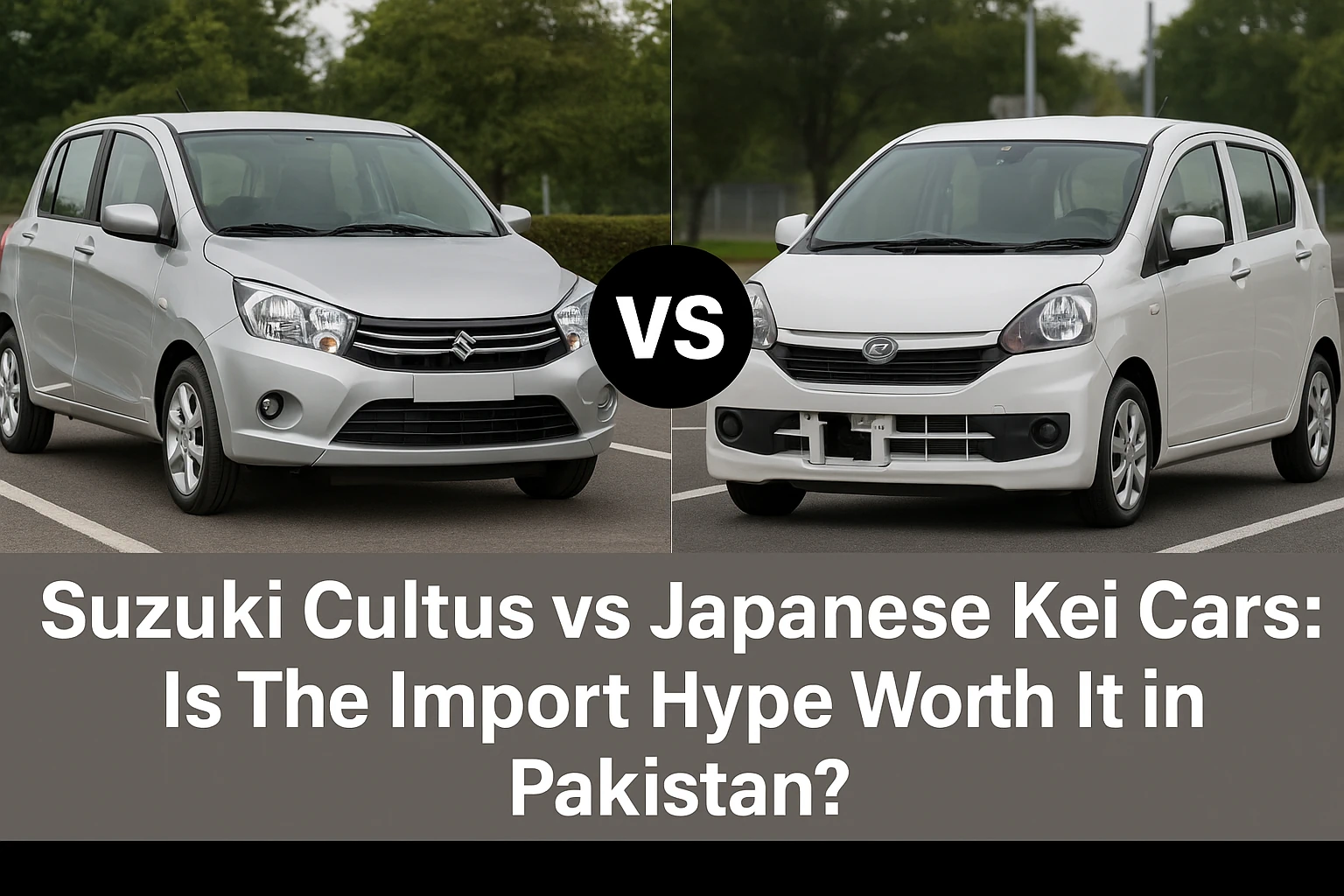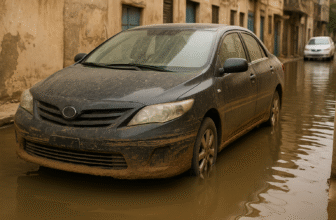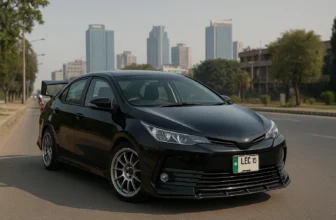
Understanding the Contenders: Cultus vs Kei Cars
If you’re shopping for a small car in Pakistan, you will inevitably compare the Suzuki Cultus and Japanese Kei cars like the Mira and Japanese Alto. The Cultus is the backbone of many families, trusted for its simple 998cc engine, durable suspension, and parts that are easily found across Karachi, Lahore, and smaller cities. It’s practical and predictable, which is why mechanics know it inside out, ensuring quick, low-cost repairs.
Japanese Kei cars, on the other hand, attract buyers with their sleek designs and modern features like push-start, keyless entry, and digital climate control. These 660cc cars paired with CVT transmissions promise smooth, efficient city drives while fitting perfectly into tight parking spots. But while they feel modern, they also bring a few compromises, especially in high-speed stability and parts sourcing for certain electronic components. Choosing between these options is not just about what looks better in your driveway; it’s about how you drive, where you drive, and what you expect in everyday practicality.
Fuel Efficiency and Real-World Performance
Everyone talks about mileage, but Pakistan’s traffic and climate test every car’s claims. On paper, Kei cars often promise 20-24 km/l, while the Cultus claims 17-20 km/l. But in the real world:
- Cultus: Delivers around 13-15 km/l in Karachi and Lahore’s stop-and-go traffic with AC, providing stable highway performance and confidence during overtakes and hill climbs.
- Kei Cars: Often achieve 15-18 km/l in city driving if maintained well, making them fuel-friendly for daily commutes, school runs, and quick errands.
For city-centric buyers, Kei cars feel efficient and easy to maneuver through narrow streets and tight parking spaces. However, if you frequently travel between cities or carry passengers and luggage, the Cultus’ bigger engine is noticeably better for comfort and control on highways and inclines. AC performance also matters more than people think. The Cultus typically offers consistent cooling during Karachi’s brutal summers, while Kei cars can struggle to maintain cold air when fully loaded or idling in long traffic jams. If your lifestyle is mostly short, urban drives, a Kei car will help you save fuel. For mixed urban-highway use, the Cultus remains a more versatile and comfortable choice.
Maintenance and Spare Parts Availability in Pakistan
One of the biggest advantages of owning a Cultus is the peace of mind that comes with easy, affordable maintenance. Whether you’re in Karachi’s Plaza Market or Lahore’s Montgomery Road, you’ll find genuine and aftermarket parts without hassle. Most mechanics are comfortable working on Cultus, and routine services like oil changes, brake pad replacements, and suspension repairs are quick and budget-friendly.
Kei cars are getting easier to maintain in Pakistan as their popularity grows, and parts are increasingly available in places like Shershah and Bilal Gunj. However, there are some realities buyers should consider:
- Kei cars often rely on sensors and electronics that require proper diagnostic scanners, which not all workshops have.
- Parts like CVT transmission components and electronic modules can be expensive and sometimes require waiting for imports if not in stock.
- Routine maintenance (oil, filters, brakes) remains affordable, but unexpected electronic or transmission repairs may result in longer downtime.
If you want a straightforward, low-stress ownership experience, the Cultus makes sense, especially for families who value reliability. However, if you are willing to deal with occasional extra effort in exchange for better features and comfort during your daily drives, a Kei car can still be a smart choice in Pakistan’s evolving car market.
Resale Value and Market Liquidity
Resale value matters in Pakistan, where cars often double as financial safety nets. The Suzuki Cultus holds a strong position in this regard, maintaining good resale value across Karachi, Lahore, and Islamabad due to its local popularity and serviceability. Many buyers actively search for well-maintained Cultus units, and if you need to sell, it typically moves faster without heavy negotiations.
Japanese Kei cars also retain decent resale, especially models like the Mira and Japanese Alto with verified auction sheets and clean import history. However, Kei cars can have slightly more price fluctuation based on:
- Changes in import duties
- Fuel prices influencing small-car demand
- Buyer concerns over parts availability and electronic repairs
If you’re in a major city, you will find a decent market for Kei cars, but in smaller cities, the Cultus is easier to liquidate due to familiarity and lower perceived risk among buyers. If your priority is an easy resale with less hassle, the Cultus will give you that flexibility, while Kei cars are best for buyers who plan to keep their vehicle longer to fully enjoy the features and fuel savings before reselling.
Comfort and Safety Features Comparison
If you’re looking for a car that feels modern, Japanese Kei cars stand out. Many models come equipped with features that local cars in the same price bracket rarely offer:
- Push-start ignition and keyless entry
- Digital climate control and auto AC
- Multiple airbags and ABS brakes
- Parking sensors and reversing cameras
These features make daily commuting more comfortable, especially for city drivers who value convenience in tight traffic and narrow parking spots. However, Kei cars are smaller by design, limiting rear passenger space and luggage capacity if you frequently travel with family or heavy bags.
The Cultus, while simpler, offers:
- Better ground clearance for speed breakers and rough patches
- Spacious seating for small families
- Basic but effective AC that handles summer heat well
- ABS and dual airbags (in VXL variant) for added safety
While it lacks some of the advanced features of Kei cars, the Cultus feels less cramped and offers a more relaxed ride on uneven roads. If you value tech features and comfort for city use, Kei cars are appealing. If you prioritize space and simplicity, especially for family trips within Pakistan, the Cultus holds its own.
Cost of Ownership: A 3-Year Projection
Before you decide, it’s practical to look at what it will cost you to keep these cars for three years in Pakistan. Below is a realistic projection considering fuel, maintenance, unexpected repairs, insurance, and depreciation:
| Expense Category | Suzuki Cultus | Daihatsu Mira (Kei Car) |
|---|---|---|
| Fuel (15 km/l average) | PKR 450,000 | PKR 375,000 |
| Insurance & Token Tax | PKR 55,000 | PKR 48,000 |
| Routine Maintenance | PKR 60,000 | PKR 65,000 |
| Unexpected Repairs | PKR 30,000 | PKR 50,000 |
| Depreciation | PKR 400,000 | PKR 375,000 |
| Total (3 Years) | PKR 995,000 | PKR 913,000 |
Kei cars will typically save you on fuel and have slightly lower depreciation, but they may incur higher repair costs, especially for electronic or CVT-related issues. The Cultus will cost a bit more in fuel but makes up for it with lower unexpected repairs and a stronger resale network. Your decision should align with whether you value feature-rich daily comfort with lower fuel bills (Kei car) or predictable ownership and robust resale with flexibility for highway use (Cultus).
Conclusion
Choosing between the Suzuki Cultus and a Japanese Kei car isn’t just a matter of features or fuel averages; it’s about what truly fits your lifestyle in Pakistan. If you are looking for a hassle-free ownership experience with easy parts availability, quick repairs, and a car that holds its value well across Karachi, Lahore, and smaller cities, the Cultus is a solid, practical choice. It is versatile for city and occasional highway trips, offers decent comfort, and ensures you are not left stranded due to unavailable parts or complex electronic issues.
On the other hand, if your daily routine revolves around city driving and you value features like push-start, auto climate control, and a quieter cabin, Kei cars like the Mira and Japanese Alto bring comfort and efficiency that make your daily commutes more pleasant. They excel in fuel economy, offer a modern driving feel, and are a joy to maneuver through narrow streets and tight parking spaces. However, they require a bit more diligence in maintenance, and it is wise to build a relationship with a mechanic who understands these imports to ensure long-term reliability.
Ultimately, your choice should reflect how you use your car, your appetite for managing occasional parts or sensor sourcing challenges, and what you prioritize—simplicity and robust resale or a modern, feature-rich driving experience with fuel savings. Both the Cultus and Kei cars have their place in Pakistan’s roads, and making an informed decision will ensure your next purchase truly aligns with your needs rather than just market trends.
If you found this guide helpful, consider downloading our “Cultus vs Kei Car Comparison Checklist” to take with you when visiting showrooms or dealers. For buyers in Karachi, Lahore, and Islamabad, you can also book a pre-purchase inspection with Tyre Point to ensure your next car is free of hidden faults, giving you peace of mind and confidence in your investment.






